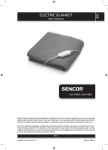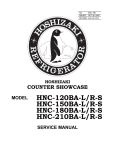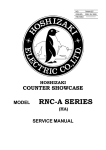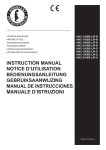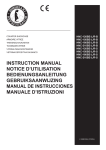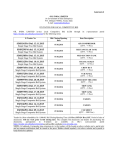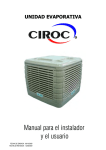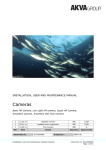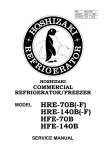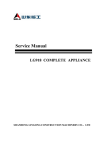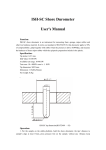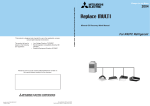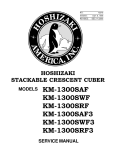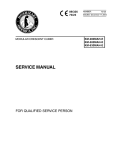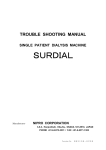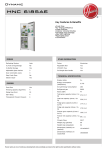Download HNC-BE Service Manual
Transcript
NO. S051-800 ISSUED: MAR. 26, 2010 REVISED: HOSHIZAKI COUNTER SHOWCASE HNC-120BE-L/R-B HNC-150BE-L/R-B HNC-180BE-L/R-B HNC-210BE-L/R-B MODEL SERVICE MANUAL IMPORTANT This manual should be read carefully before the showcase is serviced or maintenance operations are performed. Only qualified service technicians should install, service, and maintain the showcase. Read the warnings contained in this booklet carefully as they give important information regarding safety. Please retain this booklet for any further reference that may be necessary. CONTENTS PAGE 1. SAFETY INSTRUCTIONS----------------------------------------------------------------------------- 1 2. MODEL NAME-------------------------------------------------------------------------------------------- 3 3. OPERATING INSTRUCTIONS----------------------------------------------------------------------- 4 4. DIMENSIONS/SPECIFICATIONS------------------------------------------------------------------- 5 [a] HNC-120BE-L-B------------------------------------------------------------------------------------- 5 [b] HNC-120BE-R-B------------------------------------------------------------------------------------- 6 [c] HNC-150BE-L-B------------------------------------------------------------------------------------- 7 [d] HNC-150BE-R-B------------------------------------------------------------------------------------- 8 [e] HNC-180BE-L-B------------------------------------------------------------------------------------- 9 [f] HNC-180BE-R-B----------------------------------------------------------------------------------- 10 [g] HNC-210BE-L-B------------------------------------------------------------------------------------11 [h] HNC-210BE-R-B----------------------------------------------------------------------------------- 12 5. REFRIGERATION CIRCUIT------------------------------------------------------------------------ 13 6. WIRING DIAGRAM------------------------------------------------------------------------------------ 14 7. CONSTRUCTION-------------------------------------------------------------------------------------- 15 8. REMOVAL AND REPLACEMENT----------------------------------------------------------------- 16 [a] SIDE COVER--------------------------------------------------------------------------------------- 16 [b] TOP COVER---------------------------------------------------------------------------------------- 16 [c] FRONT GLASS------------------------------------------------------------------------------------ 16 [d] SIDE FRAME--------------------------------------------------------------------------------------- 17 [e] CENTER FRAME---------------------------------------------------------------------------------- 17 [f] HOLDER - EVAPORATOR PIPE-------------------------------------------------------------- 17 [g] UNIT-------------------------------------------------------------------------------------------------- 17 9. REFRIGERANT SERVICE INFORMATION------------------------------------------------------ 18 10. CONSTANT PRESSURE EXPANSION VALVE AND REFRIGERANT CHARGE----- 19 [a] SPECIFICATIONS--------------------------------------------------------------------------------- 19 [b] FUNCTION------------------------------------------------------------------------------------------ 19 i [c] CONSTRUCTION--------------------------------------------------------------------------------- 19 [d] REPLACEMENT----------------------------------------------------------------------------------- 20 11. SERVICE DIAGNOSIS------------------------------------------------------------------------------- 21 ii 1. SAFETY INSTRUCTIONS The following instructions contain important safety precautions and should be strictly observed. The terms used here are defined as follows: WARNING: There is a possibility of death or serious injury for the service person and a third party or the user due to improper service operations or defects in serviced products. CAUTION: There is a possibility of injury for the service person and a third party or the user or damage to their property* due to improper service operations or defects in serviced products. * The term “damage to their property” here refers to extensive damage to household effects, houses and pets. WARNING 1. Always ask the user to keep children away from the work area. They may be injured by tools or disassembled products. 2. When there is no need to energize the unit during disassembly or cleaning, be sure to unplug the unit or disconnect the main power supply before servicing the unit to prevent electric shocks. 3. If the unit must be energized for inspection of the electric circuit, use rubber gloves to avoid contact with any live parts resulting in electric shocks. 4. Keep the following in mind when servicing the refrigeration circuit: (1) Be sure to recover the refrigerant. Do not discharge it into the atmosphere. It will affect the environment. (2) Check for any flames in the vicinity, and ensure good ventilation. (3) If the refrigerant should leak in servicing, immediately put out any fire used in the vicinity. (4) When unbrazing the refrigeration circuit connections, check that the circuit is completely evacuated. The refrigerant may produce a poisonous gas when coming in contact with an open flame. (5) Do not braze in an enclosed room to prevent carbon monoxide poisoning. (6) In case of a refrigerant leak, locate and repair the leaking part completely. Leaked refrigerant may produce a poisonous gas when coming in contact with an open flame. 1 (7) Before servicing, check the surface temperature of the refrigeration circuit to prevent a burn. 5. Keep the following in mind when making electrical connections: (1) Check for proper grounding connections, and repair if necessary to prevent electric shocks. (2) Always use service parts intended for the applicable model for replacement of defective parts. Use proper tools to secure the wiring. Otherwise abnormal operation or trouble may occur and cause electric leaks or fire. (3) Check for proper part installations, wiring conditions and soldered or solderless terminal connections to avoid fire, heat or electric shocks. (4) Be sure to replace damaged or deteriorated power cords and lead wires to prevent fire, heat or electric shocks. (5) Cut-off lead wires must be bound using closed end connectors or the like, with their closed ends up to avoid entrance of moisture that could lead to electric leaks or fire. (6) After servicing, always use a megohmmeter (500V DC) to check for the insulation resistance of at least 1 megohm between the live part (attachment plug) and the dead metal part (grounding terminal). (7) Do not service the electrical parts with wet hands to prevent electric shocks. (8) The capacitors used for the compressor and other components may be under high voltage and should be discharged properly before servicing. CAUTION 1. After servicing, follow the instructions below: (1) Check for water leaks in the water supply and drain pipes to prevent damage to the vicinity including household effects. (2) Always check the unit for proper operation before finishing services. (3) Be sure to reassemble the parts completely. Loose assembly of such parts as control box cover may cause entrance of vermins resulting in a short circuit between terminals and possible ignition. 2 2. MODEL NAME H NC - 120 B E - L/R - B High Grade Color of Exterior B: Black Counter Showcase Unit Location Width (cm) L: Unit on left 120, 150, 180, 210 R: Unit on right Development Order HE model Starts from A Unit on right Unit on left 3 3. OPERATING INSTRUCTIONS IMPORTANT Hoshizaki Counter Showcase is intended for temporary food display. Constructed with much glass, this showcase gives relatively insufficient heat insulation and poor cooling performance compared with refrigerators in general. For safe and efficient operation, be sure to follow the instructions below. 1) Do not leave foods in the showcase after service hours, or they may dry or spoil. Foods that should not dry must be covered or wrapped up in a plastic film. 2) Store only pre-refrigerated items in the showcase. It takes longer for foods to cool in the showcase than in a refrigerator. 3) Do not leave the doors open or open them too frequently. The interior temperature may rise, resulting in food deterioration. 4) Do not pack the showcase with foods. The cooling performance may reduce, resulting in food deterioration. 5) The showcase should not be exposed to direct sunlight or located next to ovens, grills or other high heat producing equipment. The interior temperature may rise, resulting in food deterioration. 6) The ambient temperature should not exceed 30°C. The cooling performance may reduce, resulting in food deterioration. 7) The food mount can be used on either side. The food temperature is controllable by turning over the food mount to change the distance from the interior bottom. Normal condition When food temperature is too low For more intensive cooling 8) The maximum safe height for displaying food products is 3.5” (9 cm) above the interior bottom. Food products should not be placed above this height as they may not remain cold enough to avoid spoilage. 4 4. DIMENSIONS/SPECIFICATIONS [a] HNC-120BE-L-B 5 [b] HNC-120BE-R-B 6 [c] HNC-150BE-L-B 7 [d] HNC-150BE-R-B 8 [e] HNC-180BE-L-B 9 [f] HNC-180BE-R-B 10 [g] HNC-210BE-L-B 11 [h] HNC-210BE-R-B 12 5. REFRIGERATION CIRCUIT Expansion Valve Drier Evaporator (Upper) Fan Motor Condenser Evaporator (Lower) Compressor Heat Exchange Refrigerant: R134a 13 6. WIRING DIAGRAM 14 7. CONSTRUCTION Front Glass Plug Condenser Top Cover Nameplate Joint Power Switch (Ground Fault Interrupter) Center Frame Air Filter Louver Sliding Glass Door 15 Food Mount Slider Hose 8. REMOVAL AND REPLACEMENT CAUTION 1. Be sure to unplug the showcase before removing or replacing the parts. 2. Handle the glass parts with care. [a] SIDE COVER Remove the two machine screws at the bottom, lift up the side cover, and unhook the top. [b] TOP COVER Top Cover Top Frame Remove the sliding door and side cover. 1) The top cover is hooked and fixed on the top frame (aluminum). 2) Lift up and unhook the rear end of the top cover. 3) When the rear part is lifted off, move it forward to unhook and remove the front part. The top cover is tightly hooked on the top frame and will not come off easily. Remove it with care to avoid injury. To replace, reverse the removal procedure. Fig. 1 [c] FRONT GLASS Remove the sliding door, side cover and top cover. Lift the front glass off the bottom fit. The bottom and side interior of the front glass is sealed with silicone sealant (black). Be sure to re-seal it at replacement. Top Frame Front Glass Fig. 2 16 [d] SIDE FRAME Remove the sliding door, side cover and top cover. Unbind the wiring on the side frame. Remove the two screws securing the top frame and the top of the side frame. Lift the side frame off the bottom fit. [e] CENTER FRAME (Except HNC-120 type) Remove the two flat head machine screws (black) securing the center frame to the rear and the two machine screws securing the center frame to the top frame. Tilt the center frame and release it from the fit. Fig. 3 [f] HOLDER - EVAPORATOR PIPE Remove the truss head tapping screw (4 x 25) from the bottom of the top frame. Take off the center frame. Be careful with the evaporator pipe. It will be released and hang down. Remove the truss head tapping screw (4 x 10) from the bottom of the top frame. Holder Evaporator Pipe Truss Head Tapping Screw 4 x 25 Evaporator Pipe Truss Head Tapping Screw 4 x 10 Fig. 4 Outlet Pipe Expansion Valve [g] UNIT Remove the sliding door, side cover, top cover, top frame and side frame. Take off the compressor terminal cover and remove the starter and motor protector. Uninsulate the expansion valve and unbraze the outlet pipe with a gas burner (see “11. CONSTANT P R E S S U R E E X PA N S I O N VA LV E A N D REFRIGERANT CHARGE”). Unbraze the joint indicated. Remove the four machine screws securing the unit base. The whole unit can be pulled out. Joint Fig. 5 17 9. REFRIGERANT SERVICE INFORMATION 1) Allowable Compressor Opening Time and Prevention of Lubricant Mixture [R134a] The compressor must not be opened more than 30 minutes in replacement or service. Do not mix lubricants of different compressors even if both are charged with R134a, except when they uses the same lubricant. 2) Treatment for Refrigerant Leak [R134a] If a refrigerant leak occurs in the low side of a showcase charged with R134a, air may be drawn in. Even if the low side pressure is higher than the atmospheric pressure in normal operation, a continuous refrigerant leak will eventually lower the low side pressure below the atmospheric pressure and will cause air suction. Air contains a large amount of moisture, and ester easily absorbs a lot of moisture. If a showcase charged with R134a has possibly drawn in air, the drier must be replaced. Be sure to use a drier designed for R134a. 3) Handling of Handy Flux [R134a] Repair of the refrigerant circuit needs brazing. It is no problem to use the same handy flux that has been used for the current refrigerants. However, its entrance into the refrigerant circuit should be avoided as much as possible. 4) Oil for Processing of Copper Tubing [R134a] When processing the copper tubing for service, wipe off oil, if any used, by using alcohol or the like. Do not use too much oil and let it into the tubing, or wax contained in the oil will clog the capillary tubing. 5) Service Parts for R134a Some parts used for refrigerants other than R134a are similar to those for R134a. But never use any parts unless they are specified for R134a because their endurance against the refrigerant have not been evaluated. Also, for R134a, do not use any parts that have been used for other refrigerants. Otherwise, wax and chlorine remaining on the parts may adversely affect R134a. 6) Replacement Copper Tubing [R134a] The copper tubes currently in use are available for R134a. But do not use them if oily inside. The residual oil in copper tubes should be as little as possible. (Low residual oil type copper tubes are used in the shipped units.) 7) Evacuation, Vacuum Pump and Refrigerant Charge [R134a] Never allow the oil in the vacuum pump to flow backward. The vacuum level and vacuum pump may be the same as those for the current refrigerants. However, the rubber hose 18 and gauge manifold to be used for evacuation and refrigerant charge should be exclusively for R134a. 8) Refrigerant Leak Check Refrigerant leaks can be detected by charging the unit with a little refrigerant, raising the pressure with nitrogen and using an electric detector. Do not use air or oxygen instead of nitrogen for this purpose, or rise in pressure as well as in temperature may cause R134a to suddenly react with oxygen and explode. Be sure to use nitrogen to prevent explosion. 10. CONSTANT PRESSURE EXPANSION VALVE AND REFRIGERANT CHARGE [a] SPECIFICATIONS Model: Manufacturer: Part Number: Refrigerant: Adjustment Range: Pressure Rise by Adjusting Screw: HYP-2-5QHD-1 Fuji Koki 447283-01 R134a 0.01 - 0.29MPa 0.039 - 0.049MPa / turn [b] FUNCTION When the low side pressure drops, the Constant Pressure Expansion Valve opens and lets the refrigerant flow to keep a constant pressure. [c] CONSTRUCTION IN (High Pressure) Adjusting Screw Cap Needle Valve OUT (Low Pressure) Close Open DOWN UP Low Pressure Working Bar Adjusting Spring Diaphragm Fig. 6 19 Inner Spring [d] REPLACEMENT WARNING Always protect the valve body by using a damp cloth to prevent the valve from overheating. Do not braze with the valve body exceeding 110°C. IMPORTANT Always install a new Drier every time the sealed refrigeration system is opened. Do not replace the Drier until after all other repairs or replacement have been made. 1) Recover the refrigerant (R134a) and store it in an approved container. 2) Remove the Insulation Cover and Cap from the Expansion Valve. 3) Remove the Expansion Valve by heating the Inlet and Outlet Pipes with a gas burner. Wet Cloth Evaporator Burner Burner Drier Fig. 7 20 11. SERVICE DIAGNOSIS PROBLEM POSSIBLE CAUSE [1] Showcase will not 1. Ground fault circuit interrupter in start. OFF position. 2. Unplugged. 3. Supply voltage too low. [2] Poor cooling performance [3] Dry foods [4] Frosting 1. Turn ON. REMEDEY 2. Plug in. 3. Plug into a separate receptacle of 220 - 240V ± 6%. 4. No power supply to the wall outlet. 4. Correct. (Breaker or fuse blown out.) 5. Electrical circuit open or bad 5. Correct. contacts. 6. Motor protector tripped. 6. Ventilate and reset fan motor. 1. Gas leaks. 1. Repair the leaks and recharge. 2. Fan motor defective. 2. Replace. 3. Condenser and/or air filter clogged. 3. Clean. 4. Condenser air inlet blocked. 4 - 9. Instruct the user on characteristics and proper use 5. Exposed to direct sunlight. of the showcase. 6. Located next to a high heat producing equipment. 7. Doors opened too frequently or left open. 8. Packed with foods, or warm or hot foods inside. 9. Ambient temperature exceeding 30°C. 1. Foods have been stored from the 1 - 2. Instruct the user on previous day. characteristics and proper use of the showcase. 2. Foods have been stored for a long time. 1. [Exterior] Relative humidity 1 - 2. Instruct the user on exceeding 60%. characteristics and proper use of the showcase. Wipe off 2. [Interior] Doors opened too excessive frost with a soft cloth. frequently or left open. 21
























